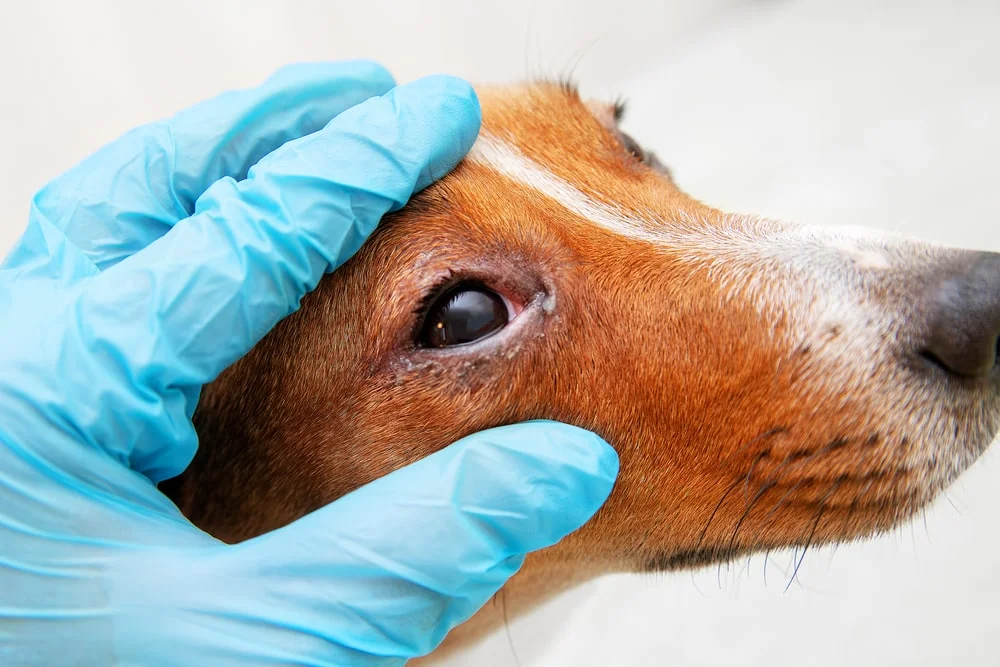PET HEALTH
Your pet’s eye health is important, and some health conditions can threaten your dog’s vision. Entropion is an eye condition that can be very painful for your furry friend. If you find your pup with a case of eyelid entropion, surgical correction is typically the only treatment option.1
Learn more about what causes eyelid entropion in dogs, what breeds may be prone to this condition, treatment, costs, and how a dog insurance policy can help you cover vet expenses.
Eyelid Entropion May Hurt Your Pet and Your Wallet
How Much Does Entropion Surgery for Dogs Cost?
The cost of an entropion operation can depend on a few factors, including who performs the surgery, where you live, the severity of entropion, and if it’s in one or both eyes. On the lower end of the spectrum, the procedure could cost $500.1 On the higher end, it may cost around $2,000 or more — especially if a veterinary ophthalmologist performs the operation.1
There may be other costs associated with surgery — like anesthesia, medications, follow-up care, or preoperative blood work — along with the costs of any other treatments needed as a result of entropion. Be sure to discuss these with your vet so you can get a more accurate estimate for your vet bill.
Fortunately, a pet insurance policy could help you cover the costs of entropion surgery, diagnostic testing, and follow-up appointments.
What Is Entropion in Dogs?
Eyelid entropion in dogs is a condition where the eyelid rolls inward. When the eyelid rolls inward and rubs against the eye, it can cause pain, scratches, perforation, corneal ulcers, and corneal pigmentation — all of which can affect vision.2,3
There are two main types of entropion: primary and secondary.3
What causes primary and secondary entropion in dogs?
Primary entropion is genetic, so dogs are born with it. The cause is an eyelid that’s shaped in a way that’s not complementary to the shape of the eyeball, whether that’s due to the eyelid length, head shape, excessive skin folds around the eyes, eye socket depth, or a combination.3
Secondary entropion can be caused by eye trauma, infections, inflammation, scarring, conditions like glaucoma, or from skull muscle or fat loss that leads to a dog’s eyes sinking deeper into their sockets.2,3,4
While primary and secondary entropion are the main types, a dog may also experience spastic, or temporary, entropion.3,4 This can happen when a painful eye condition, like a corneal ulcer or uveitis, causes a dog to squint so much the eye temporarily rolls inward.3,4 Once the pain subsides enough for the dog to stop squinting, the temporary entropion should resolve.3
Breeds that may be predisposed to entropion
Many breeds may have a higher genetic predisposition for entropion — some of them include:2,3
- Saint Bernard
- English bulldog
- Irish setter
- Mastiff
- Pug
- Poodle
- Shar-pei
- Great Dane
- Golden retriever
- Chow chow
However, it’s important to note that any dog can develop entropion.
Signs of Eyelid Entropion in Dogs
Depending on the severity, signs of entropion in dogs can be easy to spot. If your dog displays any of the following, they may be suffering from eyelid entropion:2,3,4
- Excessive squinting
- Pawing at or rubbing their eye
- Keeping their eye closed
- Tearing up excessively
- Discharge (mucus or pus)
- Corneal ulcers
- Redness or swelling
- Corneal pigmentation
If you notice any of the above signs, it’s a good idea to schedule an appointment with your vet to get your dog’s eye looked at as soon as possible.
Diagnosing Entropion in Dogs
When you bring your dog to the vet, tell them which symptoms your dog is experiencing. Your vet may examine your dog’s eyelid to diagnose it as entropion. They’ll also check your dog’s eye for other damage. They may refer you to a veterinary ophthalmologist for treatment.3
An ophthalmologist can perform a fluorescein stain test to spot corneal damage. This is a virtually painless test where dye is dropped into your dog’s eye, and a cobalt blue light is used to look at the eye. The dye will stick to damaged areas, allowing the ophthalmologist to see if there’s a problem.5
Entropion Surgery in Dogs: What to Expect
Entropion surgery for dogs involves removing a small section of the eyelid, or excess skin, so the inward roll reverses and the eyelid returns to a normal position.3,6 Vets may need to perform two surgeries instead of one to reduce the risk of over-correcting and potentially causing an outward rolling eyelid, also known as ectropion.6
If surgery is required for a puppy, vets will likely wait until they’ve reached their adult size, since the pup is still growing.3 However, if the eyelid can’t wait to be corrected, a vet may opt for an eyelid tacking procedure.3,4 This involves using sutures to temporarily secure the eyelid outward while the puppy grows until permanent surgery can be done.3 Because this solution is temporary, puppies may need more than one tacking procedure.4
After-surgery care
The ophthalmologist or vet may prescribe ophthalmic antibiotics and artificial tear lubricants to help treat any other conditions that may have resulted from entropion and to prevent infection.2,6 Your dog’s eye will likely be red and swollen after the procedure, and your dog will probably need to wear an Elizabethan collar (cone) to prevent any damage while the eye heals.6 The vet or ophthalmologist will likely want a follow-up visit to check that the eye is healing well.
A successful correction of entropion can allow your dog to lead a normal life without eye pain. However, some types of eye damage due to entropion may result in vision impairment. Your vet can give you the correct prognosis for your pup’s situation.2
Pet Insurance May Help You Cover Entropion Treatment Costs
With entropion treatment potentially costing over $2,000, a dog insurance policy with MetLife Pet can help make sure you can focus on your dog getting the best care for their entropion without worrying about the bill.
Take four-year-old golden retriever Maggie, for example. This Wisconsin pup needed surgery to correct her eyelid entropion. Maggie’s parents took her to an animal ophthalmologist for surgery that cost about $3,000. Thanks to her owner’s MetLife Pet policy, they were reimbursed for just under $2,500.7
Don’t wait until health issues arise to get protection for your pet and your wallet. Get a free personalized quote today, and see what MetLife Pet can do for you.
We Can Help You Cover Vet Bills While You Focus on Your Dog’s Care
855-270-7387


